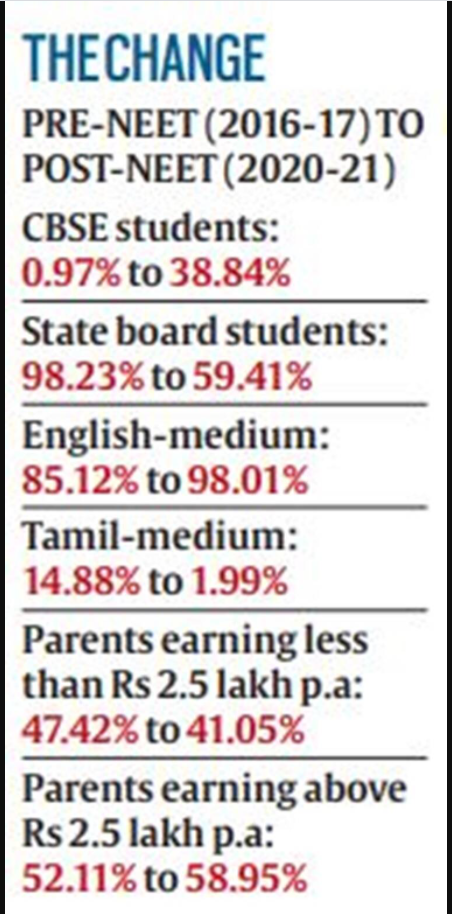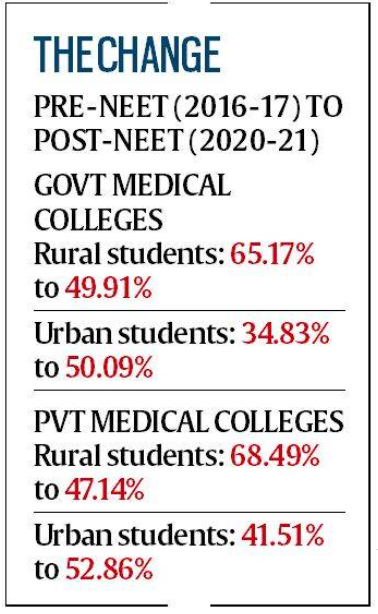ForumIAS announcing GS Foundation Program for UPSC CSE 2025-26 from 19 April. Click Here for more information.
ForumIAS Answer Writing Focus Group (AWFG) for Mains 2024 commencing from 24th June 2024. The Entrance Test for the program will be held on 28th April 2024 at 9 AM. To know more about the program visit: https://forumias.com/blog/awfg2024
Contents
| For 7PM Editorial Archives click HERE → |
Introduction
Recently, The Tamil Nadu Assembly has passed a Bill to dispense with the National Entrance cum Eligibility Test (NEET). This bill is passed based on the recommendation of the high-level committee led by retired judge AK Rajan. The committee report was prepared after looking into around 86,000 representations from various stakeholders, a majority of whom said they don’t want NEET.
The immediate trigger to the bill was the suicide of an MBBS aspirant just before the NEET this year. The Bill allows admission to medical courses based on Class 12 marks to “ensure social justice”. But, in various instances, NEET is considered the best option by the judiciary as it promotes merit. In this article, let us understand the issues surrounding the NEET.
What is the National Eligibility cum Entrance Test (NEET)?
The Medical Council of India (MCI) and Dental Council of India (DCI) in 2012 had introduced the common medical entrance examination or NEET. Later, it has been statutorily incorporated under Section 10D of the Indian Medical Council (IMC) Act. The Supreme Court also upheld the validity of the law.
The NEET replaced All India Pre-Medical Test (AIPMT). The NEET is a qualifying test for any graduate and postgraduate medical course in India. The NEET is mandatory for all Indian institutions except certain institutions including AIIMS, PGIMER, and JIPMER.
The exam is conducted by National Testing Agency (NTA). It is an autonomous body, constituted under the Ministry of Human Resources Development. It was created to conduct entrance examinations for Higher Education Institutions (HEIs) in the country.
The NEET exam is conducted online and in 11 languages. These include English, Hindi, Marathi, Odia, Tamil, Marathi, Urdu, Bengali, Telugu, Kannada, and Assamese.
Medical colleges in a particular state have 85% seats reserved for the native students and 15% (All India Quota) seats for the students from other states.
For instance, a student from Mumbai wants to pursue MBBS from a college in Delhi, then he would be choosing it from the 15% seats of the total seats of that college.
What are the changes introduced in NEET so far?
Applicable to Minority Educational Institutions: Last year, the Supreme Court ruled that the NEET is mandatory for admission to medical colleges run by religious and linguistic minority communities.
Reforms in All India Quota: In Abhay Nath v University of Delhi and Others case, 2007, the SC directed that reservation of 15% for Scheduled Castes and 7.5% for Scheduled Tribes be introduced in the All India Quota.
The government earlier implemented this reservation in all the Central Educational Institutions. But, recently, the Central government announced the extension of OBC, EWS quota within the AIQ Scheme for state medical and dental colleges also.
Scores valid for three years: In 2019, the government has cleared a proposal to extend the validity of the NEET score by three years. This is done to help students who are planning to pursue medical courses abroad.
What are the advantages of the National Eligibility-cum-Entrance Test?
One Nation, One Exam: Bottom line of NEET is One Nation, One Exam. The exam is having a single syllabus for all the students. It has standardized entrance tests to medical institutions. Further, NEET will also provide the Right to Choice for students. As, with NEET, a student can write a single exam and apply to different Universities with the same test score.
Improve the performance of State Boards: As the syllabus of the exam is based on CBSE/NCERT syllabus, the state boards will also be prompted to adopt a syllabus similar to that of CBSE. This will improve the quality of education of state boards.
Bring transparency to the admission process of private medical colleges: In 2020, the Supreme Court held that NEET is important for better administration of admissions, in view of many instances of maladministration by several private medical colleges.
Help students studying in Native language: NEET is conducted in regional languages. This helps students of different state boards, studying in their native language, in achieving their goal of becoming a doctor or a surgeon.
What are the challenges associated with the NEET?
Against the State’s power to hold admissions: “Public health, hospital and dispensaries” is a state subject. NEET might create standardization. However, it infringes upon the state governments’ power to hold entrance tests for admissions in the medical colleges funded by them.

A disadvantage for State board and Rural background students: The NEET syllabus is framed based on the CBSE/NCERT syllabus. So, this is unfair for students from State Boards and from rural areas where the standards may be lower.
Further, research from the USA mentions that standardisation of common tests goes against the poorer and underprivileged sections of the population, women, and minorities.
Apart from that, Justice A.K. Rajan panel also found that the proportion of rural students fell from an average of 61.45% (pre-NEET) to 50.81% (post-NEET).
Further, urban students are predominantly securing admissions in NEET. So, in future, they will shy away from rural postings and weaken the entire public health system.
Apart from that, after the introduction of NEET, there is a significant drop in the “first-generation” students who do Medical courses.
Unnecessary exam: Justice A.K. Rajan committee mentions that the examination had not provided any special mechanism for testing the knowledge and aptitude of the students. It suggested that the higher secondary examination of the State board itself was an ample basis for the selection of students for MBBS seats.
Apart from that, candidates with abysmally low marks in physics and chemistry in NEET, are also getting admission to private colleges through management and NRI quotas by paying high fees. This excludes ordinary students with low economic backgrounds.
The committee also found that several medical aspirants commit suicide due to exam stress every year.
Promote Coaching Factories: The standardisation of exams will lead to mushrooming of Coaching institutes to bridge the gap in School education. This is seen in India with NEET and similar other national tests such as the Joint Entrance Examination and Common Law Admission Test.

For instance, data from Tamil Nadu points out that in 2020-21, 99% of the candidates who got a medical seat in Tamil Nadu received some form of coaching. Of these, close to three quarters qualified for the exam after two or more attempts. This means a majority of those clearing NEET spent lakhs on coaching.
The rural and urban poor cannot spend lakhs of rupees to get coached for NEET and cannot afford to wait for two or three years only to prepare for the test.
Transparency: The NEET paper was leaked twice in the past. Therefore, there is not much confidence in NEET’s fairness and transparency.
Translation-related problems: Even though the test is conducted in 11 languages, they are still far from perfect. For example, In the 2018 NEET, as many as 49 questions had errors in Tamil translation. This leads to a Madras High Court order to award four marks for each of the 49 wrongly translated questions for all 1.07 lakh candidates who appeared NEET in the Tamil Language.
What should be the way forward?
A common national test for professional courses is faultless, in principle. But, it is important to prepare the ground for the implementation of the test.
Improve the syllabus of States: The state governments should try to improve the quality of their state board syllabus up to the level of the NCERT Syllabus. Further, they have to train the medical college aspirants in problem-solving for better results in competitive examinations.
Improve coaching in school to avoid Coaching Institutes: Central and state governments must provide best-in-class coaching for competitive exams. For that, the skill development of teachers is important.
Maintain State Autonomy: Center can adopt a Uniform domicile rule. So that, candidate can claim seat only in his/her state, this will maintain state autonomy.
Improve the transparency and performance of NTA: The National Testing Agency has to avoid Translation related problems and have to be transparent in framing questions. This will allow a fair admission process and improve merit.
Address the skewed societal trend: Further, India also needs to address the irrational high social value placed on medical and engineering college education across India. This will reduce the hyper-competitiveness and higher failure rate in tests such as NEET, Joint Entrance Examination.
At present, the exam may have some loopholes. But, probably, it is one of the biggest steps for bringing reforms in medical education in India. In long run, it will benefit students and strengthen the health sector of the country.




